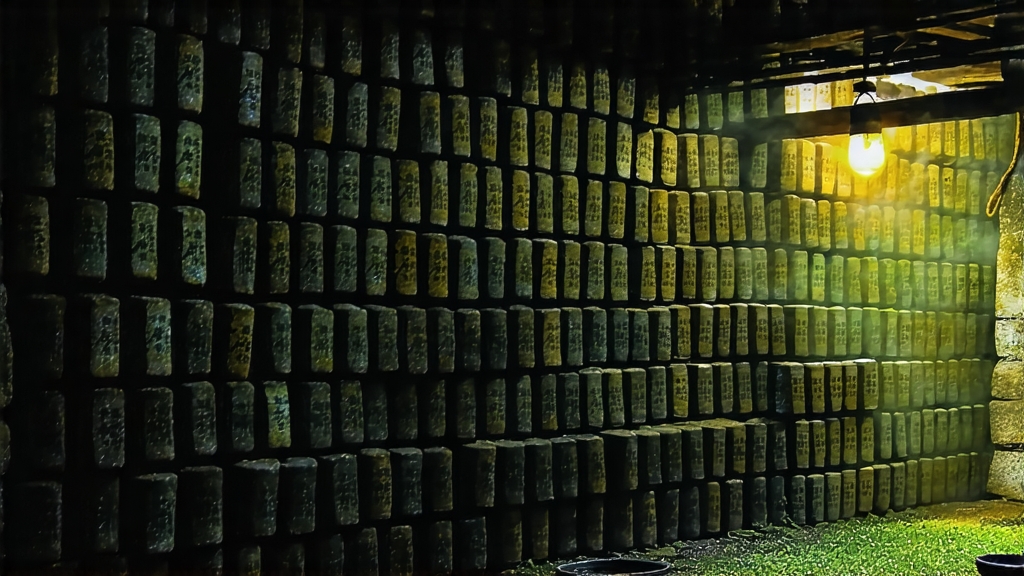
Tucked away in the southern folds of China’s Guangxi Zhuang Autonomous Region, Liu Bao tea has spent four centuries quietly fermenting its way into the hearts of dockworkers, emperors, and now, global tea lovers. Unlike the smoky drama of Lapsang Souchong or the floral fanfare of Tie Guan Yin, Liu Bao speaks in low, earthy tones—an audible whisper of damp forest floor, betel nut, and cooled campfire. To understand it is to step into a humid storeroom in Wuzhou City where time is measured not in days but in the slow creep of golden fungus on bamboo-wrapped bricks.
Historical records first name-check Liu Bao in the late Ming dynasty, when it was pressed into tight baskets and marched along the Tea-Horse Road to Southeast Asia. Traders discovered that the steamy holds of junks actually improved the tea, softening bitterness and deepening color. By the Qing, the imperial court in Beijing had designated it “medicinal tea,” dispatching it to frontier garrisons where soldiers brewed it with yak butter to counter dysentery and altitude fatigue. In 1840 the British East India Company listed Liu Bao as a commodity in Singapore, making it one of the earliest Chinese teas to be invoiced in English pounds sterling.
Today the tea is still produced exclusively within the six original mountain villages of Cangwu County—Dali, Gaojian, Dongsun, Gongping, Fozhi, and Shanzui—where the soil is a ferric red laterite that drains like coffee grounds yet holds just enough moisture to nurture the indigenous large-leaf cultivar known as Zhongxiao. Farmers insist that the same bush picked one ridge over loses its ability to “sweat” properly, the enzymic magic that defines Liu Bao.
Harvest begins at Qingming when two leaves and a bud are plucked before seven a.m. while dew still glints like broken glass. The leaves are immediately wilted on bamboo trays set at a 15-degree angle so juices migrate to the petiole, a subtle step that later concentrates sweetness. A 30-minute kill-green at 280 °C in an iron wok arrests oxidation yet keeps the leaf spine pliable; the master’s bare hand is the thermometer, pulled back the instant the tissue feels like silk soaked in warm water. Rolling follows, but here Liu Bao diverges from green-tea orthodoxy: instead of tight spirals the leaves are loosely curled into “fish-tail” strips that retain air pockets—critical for the fermentation ahead.
The signature process is wet piling, locally called “wo dui,” borrowed from nearby Guangdong exporters who borrowed it from Yunnan’s shu Pu-erh pioneers. Seven hundred kilos of leaf are heaped into a rectangular mound, sprayed with mountain spring water until moisture hits 38 percent, then covered with jute tarpaulins. Inside this compost-like core temperature climbs to 55 °C within 24 hours; every six hours a worker nicknamed the “nose” thrusts an arm into the pile, sniffing for the moment sourness fades and a lactic, rice-wine note appears. Turning and restacking happens four times over two weeks, shorter than Pu-erh to preserve some astringency that will round out during years of aging. When the leaf flakes separate like charred cedar and the liquor stains a farmer’s thumbnail chestnut, the pile is broken and sun-dried on cement courts where clucking chickens occasionally scatter the leaves—an avian quirk believed to innoculate the tea with wild yeast.
Next comes the unique basket compression. Traditionally 50 kg of fermented leaf are tamped into woven bamboo baskets lined with wild banana leaf; a barefoot worker jumps inside, compacting the tea with heel and arch until the surface can support his weight. A lid is sewn on with rattan, and the basket is rolled into a riverside cave whose relative humidity hovers at 85 percent. Here the tea naps for a minimum of three years, during which time Guangxi’s subtropical monsoon seeps through the bamboo, feeding aerobic microbes that oxidize residual catechins into theaflavins and thearubigins. The result is a liquor the color of blackstrap molasses that refracts a ruby halo when held to a Guangxi sunset.
Modern producers offer three commercial styles. “San He” is the entry level, aged only two years and sold loose; it tastes of cocoa nib and wet bark. “Lao Cha Liu Bao” designates baskets between eight and fifteen years, developing camphor and